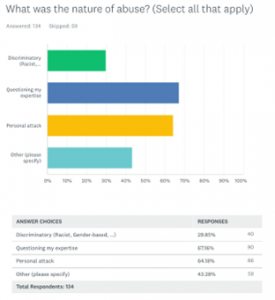Our recent questionnaire on the topic of campus safety and student abuse of faculty garnered 193 responses. Of these, 121 provided detailed answers to three open-ended questions included in the questionnaire:
- What was the nature of abuse? (Select all that apply, with an option for “Other” and space for specifying details.)
- Do you have suggestions on what can be done to improve campus safety?
- Do you have any additional comments?

The results from these questions are summarized below.
The “Nature of Abuse” question allowed the participants to provide comments if they chose the option “Other.” The analysis of responses reveals a variety of reported abuse types, indicating a wide range of issues. A summary of the main themes identified follows:
- Verbal Abuse: This includes instances where faculty were subjected to offensive or derogatory language.
- Sexual Harassment: Some responses highlighted incidents of sexual harassment, including inappropriate emails and comments.
- Physical Threats or Violence: A few responses indicated threats of violence or actual physical confrontations.
- Academic Dishonesty: This theme covers behaviours such as lying about academic performance or cheating, which, when apprehended, lead to aggressive and manipulative actions against faculty members.
- Disruptive Behavior: This includes behaviour that disrupts the educational environment, such as offensive email communication or classroom disturbances.
- Intimidation and Bullying: Instances where faculty felt intimidated or bullied by students were also reported.
These themes reflect a spectrum of abusive behaviours encountered by faculty, ranging from verbal and sexual abuse to physical threats and academic dishonesty. Each represents significant concerns within the academic environment about situations impacting faculty well-being and campus safety. The responses suggest a need for comprehensive strategies to address and prevent various forms of abuse in academic settings.
The analysis of the suggestions made to address the problem of campus safety and student abuse of faculty reveals a variety of approaches and ideas. Here’s a summarized overview of the key suggestions provided by the respondents:
- Implementing and Enforcing Codes of Conduct: A recurring theme is the suggestion to enforce professional codes of conduct more strictly. This includes incorporating these policies into every syllabus and ensuring students understand the consequences of violating these codes.
- Screening Student Evaluations for Abusive Comments: Some respondents suggest screening student evaluations (SLEQs) for abusive comments and treating severe or ongoing abusive feedback as potential academic misconduct.
- Training and Education: There’s a suggestion for training students, especially in professional programs, about power relationships, working to build productive relationships with colleagues and clients, and understanding privilege dynamics. The focus would be on constructive criticism and respectful communication.
- Accountability for Anonymous Evaluations: One suggestion is to require student evaluations to be signed, adding a level of accountability to feedback and potentially reducing abusive or unfounded criticism.
- Assessment of Student Preparedness: There’s a call for assessing student readiness for university-level courses, particularly in subjects like mathematics, to possibly prevent frustrations that might lead to abusive behaviours.
- Administrative Support: A respondent highlighted the need for department heads and administrators to critically assess student criticisms rather than take them at face value, suggesting that faculty evaluations should involve discussions rather than assumptions.
These suggestions indicate a multifaceted approach to addressing student abuse of faculty and improving campus safety, ranging from policy enforcement and educational initiatives to administrative changes and accountability measures. Each suggestion contributes to a broader strategy aimed at creating a safer, more respectful academic environment.
The additional comments provided by respondents offer a variety of perspectives and insights into the issue of campus safety and student abuse of faculty. Here is a summarized overview of the key points and sentiments expressed:
- Call for Administrative Action: Several respondents emphasize the need for administrative bodies, such as Associate Deans and academic departments, to take the issue of abuse seriously and to implement effective measures to address it.
- Mutual Respect: Some comments highlight the importance of mutual respect between students and faculty, suggesting that respectful treatment is often reciprocated, thereby reducing instances of abuse.
- Ongoing Issue: A few respondents note that abuse is not a new problem but has been a recurring issue throughout their careers, indicating the need for long-term solutions rather than temporary fixes.
- Impact on Faculty: Comments also reflect on the personal and professional impact of student abuse on faculty, including stress, job dissatisfaction, and concerns for personal safety.
- Suggestions for Improvement: Alongside expressing concerns, some respondents offer additional suggestions for improvement, such as better support systems for faculty, increased awareness of the issue among the academic community, and more transparent processes for addressing complaints.
- Acknowledgment of Complexity: There is an acknowledgment of the complexity of the issue, with comments suggesting that solutions require a nuanced understanding of the various factors that contribute to abusive behaviours.
These comments collectively underscore the significance of the issue, the need for institutional responsibility, the value of fostering a culture of mutual respect, and the desire for actionable steps to improve campus safety and faculty well-being.
